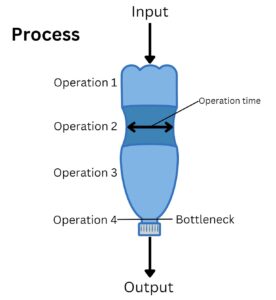Production capacity is an important element for any business.
In order to optimize the profitability of its operations, we want to sell as many products or services as possible. However, we do not want to compromise the satisfaction of our customers and our employees.
Indeed, if we try to sell more products or services than we can actually produce, then we risk encountering certain problems.
For example, we could start delivering late, lose employees due to fatigue or stress, etc.
On the other hand, we do not want to start under-producing and refuse orders or appointments that we are able to manufacture or give. This would result in a loss of revenue.
So how to produce optimally? How do we assess our production “limit”?
To do so, you have to measure its production capacity!
What is Production Capacity?
To be able to respond quickly and efficiently to our requests, you have to know your limits. You have to establish your production capacity and adapt it as needed.
Production capacity represents the maximum quantity of products or the maximum number of services that one can produce in a given period of time. It varies according to the number of available resources (manpower, machine, raw material, etc.). The capacity of a company is therefore established by the bottleneck.
What is a Manufacturing Bottleneck?
The production capacity of a company may vary depending on the productions or services to be performed. It will be directly dependent on the operation, the task, etc. the longest in the manufacturing process or service. This operation is called the production bottleneck.
The manufacturing bottleneck is the stage of a process that takes the longest to accomplish or that is the most restrictive.
In a capacity calculation context, we will take the longest step. However, the bottleneck of a business could be in sales or hardware.
We talk about the neck to illustrate the flow of a bottle that is pouring out. The rate at which the bottle empties is directly related to its size of it.
In this analogy, the liquid represents the quantity of product or service that is produced per unit of time and the neck of the bottle represents the slowest or most restrictive operation.
To establish its production bottlenecks, one of the best means remains value chain mapping. Once the bottleneck has been identified, we can work on it to increase its capacity. However, you have to be careful. Once the bottleneck improves, it can move to another operation.
How to Measure its Production Capacity?
To estimate the capacity of a company in a simple and fast way, we can divide the number of hours of work available by the number of hours required to produce a unit. However, this somewhat simplistic method is only accurate for serial operations or when there is only one operation.
In the case where a company has manufacturing processes involving several operations, we will rather divide the number of working hours available by the number of hours of the bottleneck operation.
Why? Because a company manufactures products continuously and works in parallel. That is to say that while we finish manufacturing the first unit, other employees are already starting the next one. This, therefore, decreases the total passage time of the parts and increases the production capacity.
Example 1: Capacity calculation for a service company
A chiropractor clinic is open 8 hours a day and has 6 clinicians. These take 30-minute breaks for dinner and 15-minute breaks in the morning and afternoon. A meeting with a client lasts 30 minutes.
The number of working hours available is 7 hours per day per Chiropractor. The capacity of this clinic is therefore: (6 Chiros * 7 hours/days) / 30 minutes/clients.
We, therefore, obtain a capacity of 84 clients per day for this clinic.
Example 2: Capacity calculation of a production line
ElecBox Inc. manufactures electrical boxes for various companies in the construction sector. The company manufactures three models of cases, namely a small (S-EB), a medium (M-EB), and a large (L-EB).
The three models of boxes go through the same operations, but do not require the same manufacturing times. The following table presents the manufacturing process, as well as the operation times.
|
Laser cutting (min) |
Folding
(min) |
Welding
(min) |
Assembly
(min) |
Total (min) |
|
| S-EB | 4 | 8 | 7 | 6 |
25 |
|
M-EB |
6 | 10 | 16 | 8 | 40 |
| L-EB | 10 | 12 | 20 | 13 |
55 |
Opening hours are from 8 a.m. to midnight spread over 2 shifts. Employees have a total of one hour break per shift (2x 15 minutes + 30 minutes lunch). There are therefore 14 hours of work available.
As the boxes do not all have the same manufacturing times, the company’s production capacity is not the same for each of the models. Using the formula from the previous example would yield the following results:
|
Box type |
Calculation |
Capacity |
| P-EB | 14 hours × 60 min/hours ÷ 25 min/box |
33,6 |
|
M-EB |
14 hours × 60 min/hours ÷ 40 min/box | 21 |
| G-EB | 14 hours × 60 min/hours ÷ 55 min/box |
15,2 |
However, unlike the previous example, the operations are carried out continuously and in parallel. In the previous example, a clinician could not start an encounter until he had completed 1.
Here, when a box is finished being cut, we immediately start cutting the next one while the other is being welded. So we speed up the process.
In a context of continuous production like this, we will then estimate that a finished product is manufactured each time the bottleneck step completes a unit.
In this case, the bottlenecks are folding for the small box (8 minutes) and welding for the medium and large (respectively 16 and 20 minutes). We will therefore have the following production capacities:
| Box | Calculation |
Capacity |
|
S-EB |
14 hours × 60 min/hours ÷ 8 min/box | 105 |
| M-EB | 14 hours × 60 min/hours ÷ 16 min/box |
52,5 |
| L-EB | 14 hours × 60 min/hours ÷ 20 min/box |
42 |
As can be seen, the results are not quite the same. The capacity increases, because the operations are done simultaneously versus in series. The example is simple but still presents the basic principles.
Some companies use simulation (digital twin) and the principles of 4.0 to know their capacity in real-time, even for complex processes.
Simplification of Production Planning
Most businesses have more than one product or service to offer their customers. To simplify the planning of their production, the principle of the equivalent unit is used.
To learn more about this principle, see our article on integrated production planning. You will find a complete section on this subject and how to apply it.
Conclusion
Knowing your production capacity is very important because it allows us to better plan our production and better serve our customers.
This article presents methods to estimate its capacity according to the production context (continuous VS unitary).
The article also presents the notion of the bottleneck which is essential to estimate the capacity of a production line. We also offer you a tool to target and improve your bottlenecks and your plant capacity. Value chain mapping.
Finally, we suggest that you simplify your planning by using equivalent units. A section on these is offered in our article on integrated planning.









